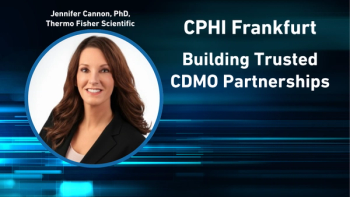
PTSM: Pharmaceutical Technology Sourcing and Management
- PTSM: Pharmaceutical Technology Sourcing and Management-05-30-2007
- Volume 3
- Issue 5
Functional Versus Full-Service Outsourcing Models
Preferred models for clinical and nonclinical services move in opposite directions.
One of the hallmarks of the growth of outsourcing in the pharmaceutical industry has been the evolution of new sourcing models. As outsourcing gains acceptance, pharmaceutical companies and contract service providers experiment with and adopt various approaches to the packaging and delivery of services. The major themes in model evolution include:
Jim Miller
- moving from bidding individual projects to establishing preferred provider relationships covering multiple projects;
- various approaches to bundling services together versus outsourcing the delivery of a single capability in support of multiple projects or studies.
Sourcing models pursued in clinical and nonclinical development services have evolved in somewhat opposite directions. For most of the past 10 years, buyers of clinical research services have preferred to buy contract research organization (CRO) services on a full-service basis. That is, they have tended to buy the range of services needed to complete a clinical study—study management, site monitoring, data management, biostatistics, and medical writing—from a single CRO for a fixed price. By contrast, buyers of nonclinical services have tended to buy the necessary services for a particular drug candidate—process development and manufacturing for active pharmaceutical ingredients, dose formulation and development, clinical packaging, and analytical services—from multiple vendors, each specializing in a particular discipline.
Company websites
Today, the trends in the two sectors are moving in opposite directions. Major pharmaceutical companies are embracing a functional outsourcing approach for clinical research under which they contract with a single provider to deliver a particular service in support of all their clinical trials. In the nonclinical realm, the trend is toward a full-service model, often referred to as the one-stop shop.
These opposing trends reflect some very different dynamics in these two sectors of the pharmaceutical services industry. The rise of functional outsourcing in clinical research is being driven primarily by the industry's embrace of clinical information technology (IT). This change brings with it the need for new areas of expertise such as systems integration as well as new opportunities to realize cost savings by offshoring software development and data processing. Creating a single data infrastructure for all clinical trials facilitates using clinical data for applications beyond the study for which it was collected, including strategic planning, marketing, and disease modeling. Contracting with a single, dedicated information technology services provider to build and maintain the clinical data infrastructure offers the promise of best-in-class capabilities and cost savings across all clinical operations.
FYI
The functional outsourcing model in clinical research has been adopted in several major pharmaceutical companies, including Pfizer (New York, NY) and Wyeth (Madison, NJ), and based on discussions at April's Partnerships with CROs conference in Orlando, Florida, more companies appear to be adopting it. Furthermore, the model is moving beyond data management into other clinical research areas: Wyeth has struck a deal with ReSearch Pharmaceutical Services, Inc. (Dallas, TX), a clinical CRO, to provide site monitors for clinical trials, and the company recently contracted with DHL (Plantation, FL) to provide logistics for distributing clinical supplies to investigator sites.
One interesting implication of the trend toward the functional model is that it has opened the door to new competitors in the clinical research sector. IT outsourcing giants Accenture (New York, NY) and Tata Consultancy Services (Mumbai, India) have become important players in clinical data management, and it is widely speculated that Federal Express and UPS will join DHL in competing with established clinical packagers and couriers. That specter of increased competition from global leaders has traditional CROs very worried.
Functional outsourcing
Functional outsourcing has been the rule rather than the exception in nonclinical outsourcing. The reason has little to do with the cost and performance advantages being pursued in clinical research, however.
Instead, the predominance of the functional model in nonclinical development reflects the fact that the component disciplines of nonclinical development have very different and specific technical and operation bases and require expensive specialized capital infrastructure. (Clinical research requires very little capital investment, and its human resource requirements can be met with job-specific training in most cases.) Nonclinical services companies have traditionally been unwilling or unable to make the capital investments and assemble the expertise necessary to offer a full-service nonclinical offering. An early effort to assemble a full-service nonclinical offering, Oread, flamed out more than five years ago because it couldn't support the cost of maintaining so many capital- and technology-intensive capabilities.
One-stop shopping
The return of the one-stop-shop model in recent years reflects two major trends in the pharmaceutical industry. The first is the renewed support for early-stage companies developing new drug candidates and their focus on getting to proof-of-concept (positive results at Phase IIA) as quickly as possible. Venture-backed early-stage companies account for over 50% of the new drug candidates in early development (preclinical through Phase IIA), and their development programs are geared toward achieving proof-of-concept as quickly and cheaply as possible. Most of these companies lack the facilities and breadth of scientific and development know-how to manage a program to proof-of-concept, let alone to commercialization. The full-service nonclinical CROs are promising these early-stage companies a quick and cost-effective route to proof-of-concept by providing a turnkey offering with complete nonclinical capabilities and project-management skills to tie it all together.
The second trend is the interest of private equity investors in the pharmaceutical services market. The nonclinical contract services business is highly fragmented and presents many acquisition opportunities for private equity investors looking to build a large CRO operation by buying up a number of smaller operations. The full-service CRO presents a logical model around which to build an acquisition strategy.
Segmentation
As the pharmaceutical service industry continues to mature, we will see many variations of the basic full-service and functional models. Early-stage and virtual companies will tend toward the full-service model for both clinical and nonclinical services. That's because they need the regulatory and project-management expertise embedded in the full-service model along with the basic technical disciplines.
Large pharmaceutical companies are likely to use a hybrid approach, mixing and matching the models as appropriate to meet their objectives of greater flexibility and lower costs. In clinical research, data management, clinical supplies logistics, and central laboratory services will be sourced largely on the functional model, but study management and monitoring services could be provided by full-service CROs with expertise built around specific therapeutic areas. In the nonclinical area, services that are closely linked, (e.g., formulation and clinical supplies manufacturing, may be sourced on a full-service basis) but we expect functional capabilities to count more heavily in nonclinical sourcing arrangements.
Jim Miller is president of PharmSource Information Services, Inc., and publisher of Bio/Pharmaceutical Outsourcing Report, tel. 703.383.4903, fax 703.383.4905,
Articles in this issue
over 18 years ago
Peopleover 18 years ago
Expansionsover 18 years ago
Mergers, acquisitions, and restructuringover 18 years ago
Mapping a Biologics Supply Strategyover 18 years ago
Agreements and contractsNewsletter
Get the essential updates shaping the future of pharma manufacturing and compliance—subscribe today to Pharmaceutical Technology and never miss a breakthrough.




